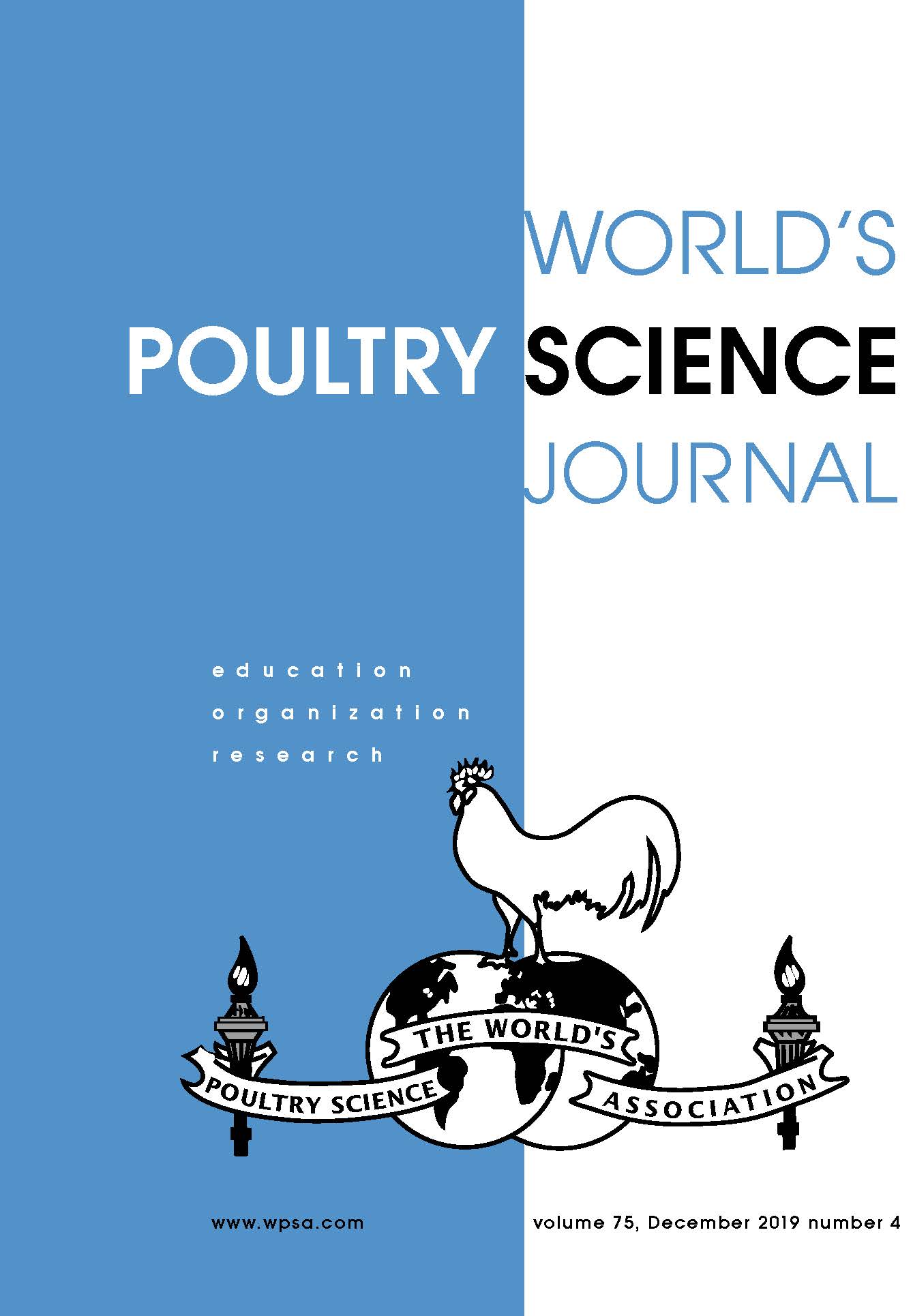Crossref Citations
This article has been cited by the following publications. This list is generated based on data provided by
Crossref.
Regmi, P.
Nelson, N.
Steibel, J.P.
Anderson, K.E.
and
Karcher, D.M.
2016.
Comparisons of bone properties and keel deformities between strains and housing systems in end-of-lay hens.
Poultry Science,
Vol. 95,
Issue. 10,
p.
2225.
Gradl, Janet A.
Curtis, Patricia A.
Jones, Deana R.
and
Anderson, Kenneth E.
2017.
Assessing the impact of egg sweating on Salmonella Enteritidis penetration into shell eggs.
Poultry Science,
Vol. 96,
Issue. 7,
p.
2393.
Classen, Henry L.
2017.
Diet energy and feed intake in chickens.
Animal Feed Science and Technology,
Vol. 233,
Issue. ,
p.
13.
Kumar, D.
Raginski, C.
Schwean-Lardner, K.
Classen, H.L.
and
Plaizier, J.
2018.
Assessing the response of hen weight, body composition, feather score, egg quality, and level of excreta nitrogen content to digestible balanced protein intake of laying hens.
Canadian Journal of Animal Science,
Vol. 98,
Issue. 4,
p.
619.
Kumar, D.
Raginski, C.
Schwean-Lardner, K.
Classen, H.L.
and
Plaizier, J.
2018.
Assessing the performance response of laying hens to intake levels of digestible balanced protein from 27 to 66 wk of age.
Canadian Journal of Animal Science,
Vol. 98,
Issue. 4,
p.
801.
Kiarie, Elijah G.
and
Mills, Alisha
2019.
Role of Feed Processing on Gut Health and Function in Pigs and Poultry: Conundrum of Optimal Particle Size and Hydrothermal Regimens.
Frontiers in Veterinary Science,
Vol. 6,
Issue. ,
Robinson, Sara
Kiarie, Elijah G.
and
Miglior, Filippo
2019.
Production and metabolic consequences of high-energy and low-crude-protein diet fed to 49-wk-old Shaver white leghorn without or with top-dressed organic selenium.
Canadian Journal of Animal Science,
Vol. 99,
Issue. 4,
p.
848.
Akbari Moghaddam Kakhki, R.
Heuthorst, T.
Wornath-Vanhumbeck, A.
Neijat, M.
Kiarie, E.
and
Plaizier, J.
2019.
Medullary bone attributes in aged Lohmann LSL-lite layers fed different levels of calcium and top-dressed 25-hydroxy vitamin D3.
Canadian Journal of Animal Science,
Vol. 99,
Issue. 1,
p.
138.
Akbari Moghaddam Kakhki, R
Heuthorst, T
Mills, A
Neijat, M
and
Kiarie, E
2019.
Interactive effects of calcium and top-dressed 25-hydroxy vitamin D3 on egg production, egg shell quality, and bones attributes in aged Lohmann LSL-lite layers.
Poultry Science,
Vol. 98,
Issue. 3,
p.
1254.
Gautron, J.
Réhault-Godbert, S.
Van de Braak, T.G.H.
and
Dunn, I.C.
2021.
Review: What are the challenges facing the table egg industry in the next decades and what can be done to address them?.
Animal,
Vol. 15,
Issue. ,
p.
100282.
Zerjal, Tatiana
Härtle, Sonja
Gourichon, David
Guillory, Vanaïque
Bruneau, Nicolas
Laloë, Denis
Pinard-van der Laan, Marie-Hélène
Trapp, Sascha
Bed’hom, Bertrand
and
Quéré, Pascale
2021.
Assessment of trade-offs between feed efficiency, growth-related traits, and immune activity in experimental lines of layer chickens.
Genetics Selection Evolution,
Vol. 53,
Issue. 1,
Akbari Moghaddam Kakhki, R.
and
Kiarie, E.G.
2021.
Effect of Escherichia coli lipopolysaccharide challenge on eggshell, tibia, and keel bone attributes in ISA brown hens exposed to dietary n-3 fatty acids prior to onset of lay.
Poultry Science,
Vol. 100,
Issue. 11,
p.
101431.
Tüzün, A. E.
Koçer, B.
Ege, G.
and
Bozkurt, M.
2021.
Influence of sunflower meal utilisation on growth performance and digestive tract traits of white strain pullets fed from 29 to 112 d of age.
British Poultry Science,
Vol. 62,
Issue. 2,
p.
285.
Korver, D.R.
2023.
Review: Current challenges in poultry nutrition, health, and welfare.
animal,
Vol. 17,
Issue. ,
p.
100755.
Alig, Benjamin N.
Ferket, Peter R.
Malheiros, Ramon D.
and
Anderson, Kenneth E.
2023.
The Effect of Housing Environment on Commercial Brown Egg Layer Production, USDA Grade and USDA Size Distribution.
Animals,
Vol. 13,
Issue. 4,
p.
694.
Castro, F.L.S.
Chai, L.
Arango, J.
Owens, C.M.
Smith, P.A.
Reichelt, S.
DuBois, C.
and
Menconi, A.
2023.
Poultry industry paradigms: connecting the dots.
Journal of Applied Poultry Research,
Vol. 32,
Issue. 1,
p.
100310.
Alig, Benjamin N.
Ferket, Peter R.
Malheiros, Ramon D.
and
Anderson, Kenneth E.
2023.
The Effect of Housing Environment on Egg Production, USDA Egg Size, and USDA Grade Distribution of Commercial White Egg Layers.
Poultry,
Vol. 2,
Issue. 2,
p.
204.
Alig, Benjamin N.
Malheiros, Ramon D.
and
Anderson, Kenneth E.
2023.
The Effect of Housing Environment on Physical Egg Quality of White Egg Layers.
Poultry,
Vol. 2,
Issue. 2,
p.
222.
de Juan, A.F.
Scappaticcio, R.
Aguirre, L.
Fondevila, G.
García, J.
Cámara, L.
and
Mateos, G.G.
2023.
Influence of the calcium and nutrient content of the prelay diet on egg production, egg quality, and tibiae mineralization of brown egg-laying hens from 16 to 63 wk of age.
Poultry Science,
Vol. 102,
Issue. 4,
p.
102491.
Wythe, L. A.
Dittoe, D. K.
and
Ricke, Steven C.
2023.
Direct-Fed Microbials and Prebiotics for Animals.
p.
59.


